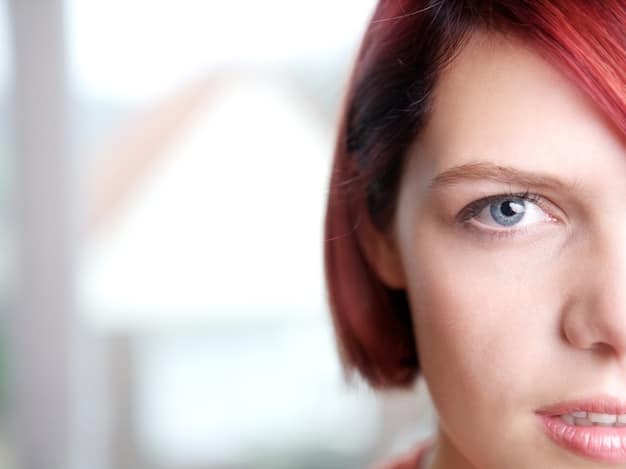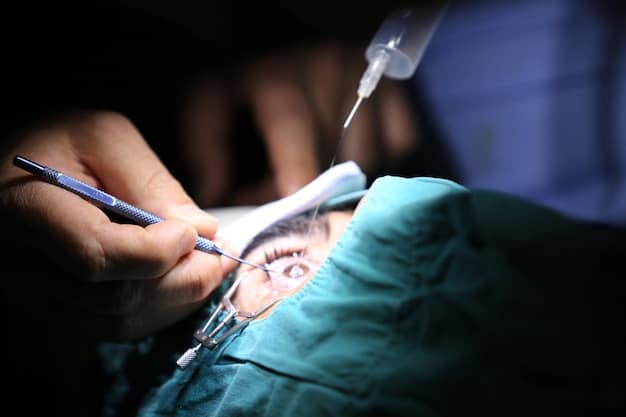Eyelid Surgery (Blepharoplasty): 2025 Recovery Timeline & Results

Eyelid surgery (blepharoplasty) in 2025 offers rejuvenated eyes by addressing sagging skin and excess fat, with recovery involving initial swelling and bruising that gradually subsides over weeks, revealing final results within a few months.
Considering eyelid surgery (blepharoplasty): What to Expect in Recovery and Results Timeline in 2025? This article provides a comprehensive overview of what to anticipate during the recovery period and when you can expect to see the final, transformative results.
Understanding Eyelid Surgery (Blepharoplasty)
Eyelid surgery, also known as blepharoplasty, is a cosmetic procedure designed to improve the appearance of the eyelids. It can be performed on the upper eyelids, lower eyelids, or both. Understanding the procedure is key to setting realistic expectations.
Who is a Good Candidate for Blepharoplasty?
Ideal candidates for blepharoplasty typically include individuals with excess, sagging skin around the eyelids, bags under the eyes, or drooping lower eyelids. It’s essential to have realistic expectations about what the surgery can achieve.
What are the Different Types of Blepharoplasty?
There are different types of blepharoplasty depending on whether the upper or lower eyelids, or both, are being treated. Functional blepharoplasty addresses vision impairment caused by drooping eyelids.
- Upper Eyelid Surgery: Focuses on removing excess skin and fat from the upper eyelids.
- Lower Eyelid Surgery: Addresses bags, wrinkles, and sagging skin under the eyes.
- Double Eyelid Surgery: Creates a crease in the upper eyelid, common in Asian blepharoplasty.
Blepharoplasty addresses both functional and cosmetic concerns related to the eyelids, offering improved vision and a more youthful appearance.

Preparing for Your Eyelid Surgery
Proper preparation is crucial for a smooth surgery and recovery. This involves consultations, medical evaluations, and specific instructions to follow before the procedure.
Consultation with Your Surgeon
During the consultation, your surgeon will evaluate your medical history, discuss your goals, and examine your eyelids to determine the best surgical approach. Be prepared to discuss any medications you are taking.
Pre-operative Instructions
Following pre-operative instructions is essential. These may include stopping certain medications or supplements, avoiding alcohol, and quitting smoking to minimize risks and improve healing.
Preparing adequately for eyelid surgery helps ensure a successful procedure and a smoother recovery.
The Eyelid Surgery Procedure: What to Expect
Knowing what to expect during the blepharoplasty procedure can ease anxiety. The process includes anesthesia, the surgical techniques used, and the duration of the surgery.
Anesthesia Options
Blepharoplasty is typically performed under local anesthesia with sedation or general anesthesia, depending on the extent of the surgery and patient preference. Your surgeon will discuss the best option for you.
Surgical Techniques
The surgical technique involves making incisions along the natural creases of the eyelids. Excess skin, muscle, and fat are removed or repositioned. The incisions are then closed with sutures.
- Upper Blepharoplasty Technique: Incisions are made in the natural crease of the upper eyelid to remove excess skin and fat.
- Lower Blepharoplasty Technique: Incisions can be made just below the lower lash line or inside the lower eyelid (transconjunctival approach) to reduce visible scarring.
- Fat Repositioning: Fat can be repositioned to fill hollow areas under the eyes for a smoother contour.
Understanding the surgical techniques involved can help ease anxiety and prepare you for the procedure.

Immediate Post-Op: The First Few Days After Surgery
The initial days after surgery are crucial for healing. It’s essential to understand immediate post-operative care, including managing swelling and bruising, pain management, and eye care.
Managing Swelling and Bruising
Swelling and bruising are common after blepharoplasty. Applying cold compresses can help reduce swelling. Keeping your head elevated also aids in minimizing these effects.
Pain Management
Pain is usually mild and can be managed with over-the-counter pain relievers. Your surgeon may prescribe stronger medication if needed. Follow their instructions carefully.
Eye Care
Keeping the eyes clean and lubricated is vital to prevent infection and promote healing. Your surgeon may prescribe eye drops or ointment. Avoid rubbing your eyes.
Proper post-operative care during the first few days is crucial for optimal healing and results.
The Recovery Timeline: Weeks 1-4
The first month after surgery involves gradual healing. Key milestones include suture removal, diminishing swelling and bruising, and returning to normal activities.
Suture Removal
Sutures are typically removed within a week after surgery. This is a quick and relatively painless procedure. Your surgeon will check the incisions to ensure they are healing properly.
Diminishing Swelling and Bruising
Swelling and bruising will gradually subside over the first few weeks. Most of the visible swelling should be gone by the end of the first month. Continued care and patience are key during this phase.
Returning to Normal Activities
You can typically return to light activities within a week, but avoid strenuous exercise for several weeks. Follow your surgeon’s recommendations regarding returning to work and other routine activities.
The recovery timeline in the first month involves suture removal, diminishing swelling and bruising, and a gradual return to normal activities.
Long-Term Recovery and Expected Results in 2025
The long-term recovery involves continued healing and refinement of results. This includes understanding when you’ll see final results, how to maintain them, and potential revisions.
When Will You See Final Results?
Final results are typically visible within a few months as residual swelling continues to resolve. The eyelids should look smoother, and you should have a more refreshed appearance.
Maintaining Your Results
Protecting your skin from sun exposure is crucial for maintaining the results. Use sunscreen and wear sunglasses. A healthy lifestyle also contributes to long-term satisfaction.
Potential Revisions
In some cases, a revision surgery may be needed to further refine the results. This is usually a minor procedure to correct any small irregularities. Discuss any concerns with your surgeon.
- Sun Protection: Consistent use of sunscreen and sunglasses to protect the delicate skin around the eyes.
- Healthy Lifestyle: Maintaining a healthy diet and staying hydrated to promote skin elasticity and overall well-being.
- Follow-up Appointments: Attending all scheduled follow-up appointments to monitor healing and address any concerns.
Long-term recovery focuses on maintaining results, understanding potential revisions, and enjoying a refreshed and rejuvenated appearance.
| Key Point | Brief Description |
|---|---|
| 🧊 Manage Swelling | Use cold compresses and elevate your head to minimize swelling. |
| 🩹 Suture Removal | Sutures are typically removed about one week after surgery. |
| 🕶️ Sun Protection | Always wear sunglasses and sunscreen to protect the healing skin. |
| 📅 Final Results | Expect to see the final results within a few months as swelling fully subsides. |
Frequently Asked Questions (FAQ)
▼
Eyelid surgery typically takes between one to three hours, depending on the extent of the surgery, whether both upper and lower eyelids are being done, and the technique used.
▼
Risks include infection, bleeding, dry eyes, difficulty closing eyes, skin discoloration, swelling, and blurred vision. Choosing an experienced surgeon can minimize these risks.
▼
The cost varies, but generally ranges from $4,000 to $8,000 depending on the surgeon’s fees, anesthesia, and facility costs. Insurance may cover functional blepharoplasty costs.
▼
If drooping upper eyelids are impairing your vision, blepharoplasty can remove the excess skin and improve your field of vision. This is known as functional blepharoplasty.
▼
The results of blepharoplasty are generally long-lasting, often many years. However, the natural aging process will continue, and some changes may occur over time.
Conclusion
Understanding the recovery and results timeline for eyelid surgery (blepharoplasty): What to Expect in Recovery and Results Timeline in 2025 is essential for setting realistic expectations and ensuring a successful outcome. With proper preparation, post-operative care, and patience, you can achieve a rejuvenated and refreshed appearance that lasts for years to come.





